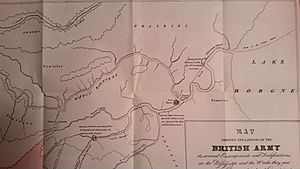Battery Bienvenue facts for kids

Battery Bienvenue was an old military fort, now in ruins, located in St. Bernard Parish, Louisiana. It was built to help protect the important city of New Orleans from attacks by sea. The battery was placed at a very important spot where two waterways, Bayou Bienvenue and Bayou Villeré, met. This location was key because the British army used Bayou Bienvenue to get close to New Orleans during the Battle of New Orleans in late 1814.
Contents
Battery Bienvenue: Protecting New Orleans
What Was Battery Bienvenue?
Battery Bienvenue was a special kind of fort called a "gun battery." This means it was a place with powerful cannons designed to defend a harbor or coastline. Its main job was to guard the water routes leading to New Orleans. The battery's location was chosen carefully. It sat at a "strategic fork" where Bayou Bienvenue and Bayou Villeré joined together. This spot was like a natural checkpoint for anyone trying to reach the city by water.
How It Was Built and Armed
The first version of Battery Bienvenue was built in 1815, right after the War of 1812. Over the years, it was made stronger and better. When it was first planned, it was meant to have one large 24-pounder cannon and two 18-pounder cannons. These numbers refer to the weight of the cannonballs they could fire.
By 1826, the plans for the battery grew much bigger. It was then designed to hold twenty-four 32-pounder cannons. It also included two large 13-inch mortars. A mortar is a type of cannon that shoots shells high into the air, making them drop down on targets. A group of soldiers, called an "artillery company," would live at the battery to operate these weapons.
Life at the Battery
The battery was quite large, about 600 feet wide. Its cannons were pointed towards Lake Borgne, ready to fire at any ships coming through Bayou Bienvenue. To protect the battery, it was surrounded by a "moat." This was a deep ditch filled with water that connected to the bayou, making it harder for enemies to attack.
Inside the battery, there was an open area called a "parade ground." Around this area, there were four important buildings:
- Barracks: Where the regular soldiers slept and lived.
- Officers Quarters: Where the officers, who were in charge, had their own rooms.
- Guardhouse: A building for guards and sometimes for holding prisoners.
- Artillery Magazine: A safe place to store gunpowder and cannonballs.
Why Was It Abandoned?
Battery Bienvenue served its purpose for many years. However, after the American Civil War, military needs changed. Newer technologies and different defense strategies meant that old forts like Battery Bienvenue were no longer as important. Because of this, the battery was finally abandoned in 1872. Today, it stands as a ruin, a reminder of its role in protecting New Orleans long ago.

